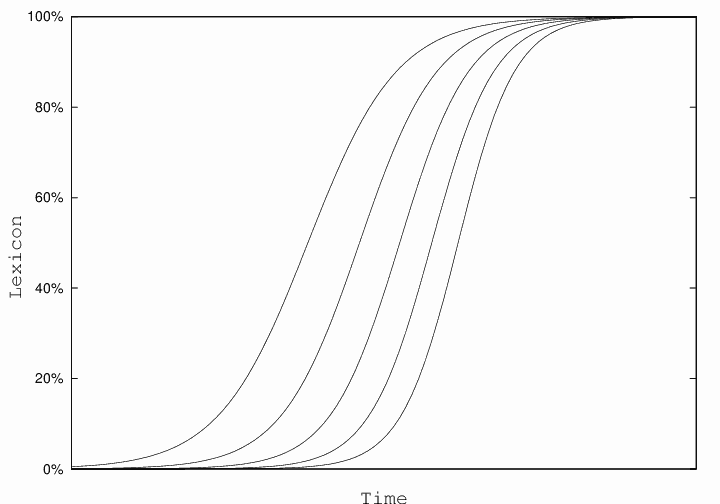昨日の記事「#1810. 変異のエントロピー」 ([2014-04-11-1]) の最後で,「遅く始まった変化は急速に進行するという,言語変化にしばしば見られるパターン」に言及した.これは必ずしも一般的に知られていることではないので,補足説明しておきたい.実はこのパターンが言語変化にどの程度よく見られることなのかは詳しくわかっておらず,この問題は私の数年来の研究テーマともなっている.
言語変化のなかには,進行速度が slow-quick-quick-slow と変化する語彙拡散 (lexical_diffusion) と呼ばれるタイプのものがある.語彙拡散の研究によると,変化を開始するタイミングは語によって異なり,比較的早期に変化に呑み込まれるものから,比較的遅くまで変化に抵抗するものまで様々である.Ogura や Ogura and Wang の指摘で興味深いのは,このタイミングの早い遅いによって,開始後の変化の進行速度も異なる可能性があるということだ.早期に開始したもの (leaders) はゆっくりと進む傾向があるのに対して,遅れて開始したもの (laggers) は急ピッチで進む傾向があるという.譬えは悪いが,早起きしたけれども歩くのが遅いので遅刻するタイプと,寝坊したけれども慌てて走るので間に合うタイプといったところか.標記に挙げた "the later a change begins, the sharper its slope becomes" は,Ogura (78) からの引用である.
私自身,初期中英語諸方言における複数形の -s の拡大に関する2010年の論文で,この傾向を明らかにした.その論文から,Ogura と Ogura and Wang へ言及している部分など2箇所を引用する.
In their series of studies on Lexical Diffusion, Ogura and Wang discussed whether leaders and laggers of a change are any different from one another in terms of the speed of diffusion. In case studies such as the development of periphrastic do and the development of -s in the third person singular present indicative, they proposed that the later the change, the more items change and the faster they change . . . . (12)
. . . the laggers catching up with the leaders in SWM C13b and in SEM C13b concurs with the recent proposition of Lexical Diffusion that "the later a change begins, the sharper its slope becomes." (14)
変化に参与する各語をそれぞれS字曲線として表わすと,例えば以下のような非平行的なS字曲線の集合となる.

ここで昨日の相対エントロピーの話に戻ろう.上のようなグラフを,Y軸を相対エントロピーの値として描き直せば,スタートは早いが進みは遅い語は,長い裾を引く富士山型の線を,スタートは遅いが進みは速い語は,尖ったマッターホルン型の線を描くことになるだろう.
語彙拡散のS字曲線,エントロピー,[2013-09-09-1]の記事で触れた「#1596. 分極の仮説」などは互いに何らかの関係があると見られ,言語変化のスピードやスケジュールという一般的な問題に迫るヒントを与えてくれるだろう.
・ Ogura, Mieko. "The Development of Periphrastic Do in English: A Case of Lexical Diffusion in Syntax." Diachronica 10 (1993): 51--85.
・ Ogura, Mieko and William S-Y. Wang. "Snowball Effect in Lexical Diffusion: The Development of -s in the Third Person Singular Present Indicative in English." English Historical Linguistics 1994. Papers from the 8th International Conference on English Historical Linguistics. Ed. Derek Britton. Amsterdam: John Benjamins, 1994. 119--41.
・ Hotta, Ryuichi. "Leaders and Laggers of Language Change: Nominal Plural Forms in -s in Early Middle English." Journal of the Institute of Cultural Science (The 30th Anniversary Issue II) 68 (2010): 1--17.